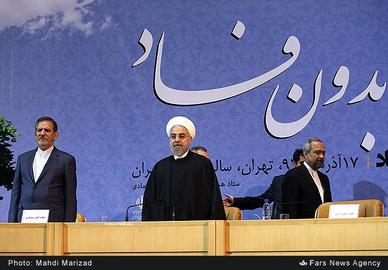More than 50 percent of the people of Isfahan believe that corruption is Iran “is now the norm and that people have to live with it.” And more than 72 percent also believe that reporting corruption to the Islamic Republic agencies responsible for tackling it only “leads to trouble.”
These are the newest findings of a field study by Iran’s General Inspection Office conducted in autumn 2017, recently reported by Evaluation Knowledge Quarterly, an inspection office publication.
Of the respondents to the survey, entitled “Investigating the Reasons for Not Reporting the Corruption: A Survey in Isfahan” [PDF], 68 percent said that it is difficult to prove that corruption has taken place in Iran. Fifty-nine percent said that nobody in the Islamic Republic pays any attention to complaints and reports about corruption and 60 percent believe that “in practice no action is taken against corrupt people.” More than 61 percent of respondents said: “I am afraid if I complain I will get into trouble.”
The field study also found that people have no idea how to report corruption — and this lack of knowledge is more prevalent among women than among men. On the other hand, more men than women believe that corruption is now normal and that people have no choice but to tolerate it.
The study was presented to the public after Transparency International published its Corruption Perception Index for the year 2017. The index, which ranks 180 countries and territories by their perceived levels of public sector corruption according to experts and businesspeople, uses a scale of 0 to 100, where 0 is highly corrupt and 100 is very ethical or trustworthy. Iran, with a score of 30, ranked 130 among 180 countries.
International anti-corruption organizations agree that the most effective way to expose corruption is for the public to exercise their supervisory power and report what they encounter. Besides exposing corruption, this would also make it an uncomfortable environment for people committing corruption, especially when it is organized.
No Laws to Protect or Encourage
But the study by the General Inspection Office shows that, at least in Isfahan, people are not enthusiastic about exercising this power. According to the study, the major factor for people’s reluctance is that Iranian laws do not effectively “protect and encourage” those who do report corruption. It concludes: “It is necessary to reform the laws to increase people’s participation in reducing corruption.”
But, as some Islamic Republic officials have implicitly confessed, the General Inspection Office itself is not above suspicion when it comes to corruption. The conservative Ahmad Tavakoli, a former member of the parliament, and Ayatollah Ahmad Jannati, Chairman of the Assembly of Experts, are two who have referred to corruption in the Islamic Republic’s supervisory bodies, and reformists have raised wider concerns about corruption within the country too.
Ordinary people themselves are unwittingly involved in corruption. The most pervasive form of corruption in Iran is the bribing of government organization employees to ensure a particular job is completed.
A 2017 Tehran Municipality study showed that corruption in both governmental and private organizations, especially in Tehran, is so pervasive that it has become the “norm” [Persian link]. The most striking finding of the study is that 65 percent of Tehran residents have bribed at least one out of 21 governmental or non-governmental organizations, thus contributing to the spread of corruption. The study warns: “Corruption has spread from the government sector to the private sector and this has turned corruption in Iran into an all-encompassing crisis.”
In January 2015, IranWire published an article entitled “Iranians Have Become Used to Corruption” [Persian link] and the new study by the General Inspection Office confirms many parts of this report. According to IranWire’s report, which was based on four surveys, 89 percent of Iranians believed that corruption had become worse and that the municipalities, the customs department, the ministry of finance and the banks were seen as the most corrupt institutions in the country.
In 2015, Parliament’s Research Center reported that, according to the members of 271 financial organizations, the corruption index in government organizations had increased between the years 2013 and 2014.
A survey conducted by the Information and Public Opinion Solutions LLC (iPOS) confirmed that Iranians believe that corruption has increased and that the banks are the most corrupt institutions in Iran. Of those polled in the survey, 77 percent said they believed that banks in Iran were ‘highly,” “very” or “relatively” corrupt.
More on corruption in Iran:
Iran’s Currency in Turmoil — Again, June 25, 2018
Is Iran Becoming More Corrupt?, March 12, 2018
Currency Plummets as Corruption and Incompetence Continues, April 18, 2018
Iran’s Latest Corruption Scandal: Who’s to Blame?, October 25, 2016
Journalist Arrested After Reporting on Corruption, September 19, 2016
Iran Blocks News Sites Following Corruption Reports, September 5, 2016
What the People Say: Banks are the Most Corrupt Institutions in Iran, January 28, 2016
A Tale of Corruption: The Missing $88million Oil Rig, September 18, 2015
Corruption Scandals Hit North Khorasan, May 20, 2015
Judicial Chief Threatens to Censor Corruption Reporting, October 28, 2014
Battling Corruption: Interview with Transparency International, October 8, 2014
visit the accountability section
In this section of Iran Wire, you can contact the officials and launch your campaign for various problems

























comments